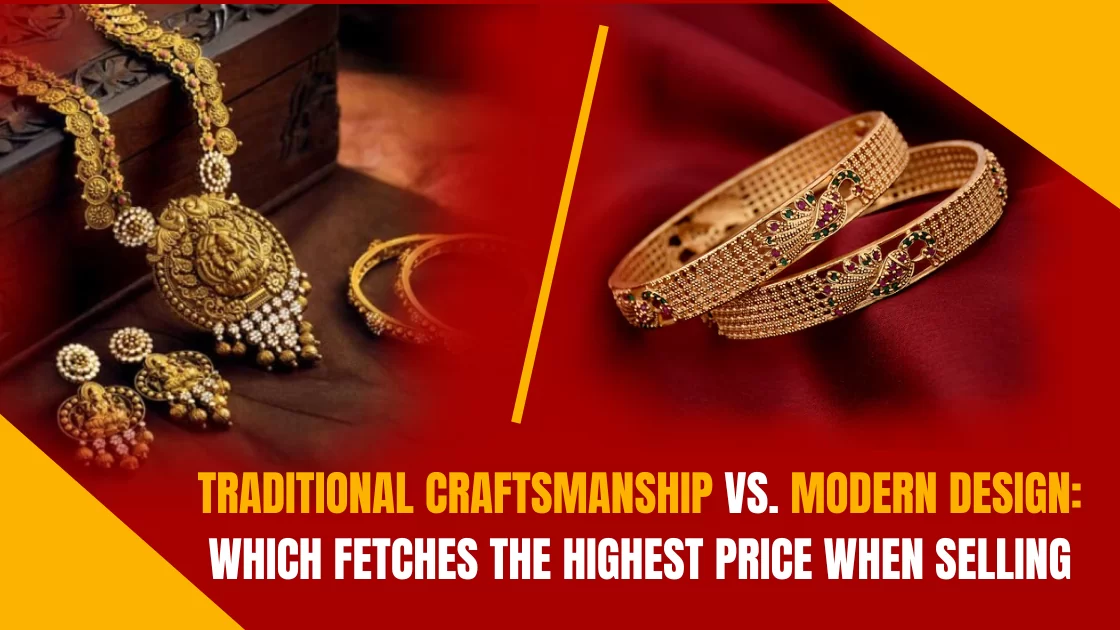Gold jewellery has been a symbol of wealth and tradition for centuries. Whether passed down through generations or bought as an investment, every piece tells a story. But when it comes to selling, which fetches a higher price: traditional craftsmanship or modern design? The answer isn’t as simple as it seems. While trends shift and buyer preferences evolve, the value of gold remains constant. In this blog, you will explore which style, traditional or modern, is more profitable when sold and the factors influencing their price.
Aesthetics and Market Demand
Traditional Craftsmanship
Gold jewellery crafted using traditional techniques is a testament to skill and patience. Intricate designs, filigree work, and hand-carved motifs define these pieces. They often carry cultural significance, making them highly desirable for collectors and antique lovers. Here’s what makes them valuable:
- Heritage and Rarity: Vintage pieces from past eras are unique, often crafted by skilled artisans using age-old techniques. These one-of-a-kind designs aren’t easy to replicate, adding exclusivity to their worth.
- Handmade Precision: Unlike modern machine-made jewellery, traditional pieces involve hours of manual labor, increasing their value. Buyers appreciate the craftsmanship, often paying a premium for it.
- Emotional and Sentimental Worth: Traditional designs evoke nostalgia, making them appealing to buyers who seek history and artistry. This can drive up demand in specific markets.
However, not all old designs fetch top prices. If the craftsmanship is exceptional, you might secure a great deal. If not, buyers may only be interested in the gold’s melt value.
Modern Design
While traditional pieces focus on heritage, modern jewellery is all about sleek lines, geometric patterns, and lightweight elegance. Minimalist gold jewellery is a popular choice for daily wear and fashion-conscious buyers. Here’s why it holds value:
- Trendy and Market-Driven: Modern designs cater to contemporary tastes. If a particular style is in demand, it can command a higher resale price.
- Brand Influence: Designer labels and high-end jewellery brands often set resale prices higher due to their market recognition. A well-known brand can increase the selling price significantly.
- Versatility: Unlike bulky traditional pieces, modern jewellery is often designed for multiple occasions, making it desirable to a larger audience.
However, modern designs age quickly. A piece that’s trendy today might be outdated in a few years, affecting its resale value.
What Fetches the Best Price? Factors That Influence Resale Value
Purity and Weight Matter More Than Style
When selling jewellery, the first thing buyers check is gold purity. Whether traditional or modern, higher purity always fetches better prices.
- 22K vs 18K: Traditional jewellery is often made of 22K gold, while modern pieces are usually 18K or lower. The purer the gold, the better the value.
- Weight-Based Pricing: Gold buyers typically pay based on weight. Heavier pieces, whether antique or contemporary, will naturally get a higher payout.
Market Trends and Buyer Preferences
Market demand fluctuates. Sometimes, vintage jewellery sees a surge in popularity; other times, modern styles dominate. Understanding what buyers want at the moment can help you sell for the best price.
- Antique Jewellery Demand: If vintage aesthetics are trending, your traditional gold jewellery could be worth more than its melt value.
- Fashion-Forward Buyers: If sleek, modern pieces are in demand, contemporary designs could command a premium over older styles.
Condition and Hallmark Certification
No matter the design, well-maintained jewellery always sells better. Scratches, dents, or missing embellishments lower value. Additionally, certified pieces with a hallmark get higher offers.
- Hallmark Assurance: A BIS-certified piece guarantees purity, giving you leverage when negotiating.
- Condition Check: Even an antique piece can lose value if it’s damaged. Regular maintenance helps in securing a better price.
So, Which One Wins?
If you’re selling strictly for gold value, traditional and modern pieces are equal contenders. The determining factor will be weight and purity. However, if the piece has historical significance, exceptional craftsmanship, or brand recognition, traditional jewellery might fetch a better price. On the other hand, if you have a trendy designer piece from a sought-after brand, modern jewellery could give you an edge.
Understanding market trends, maintaining jewellery in good condition, and verifying purity can help you maximize your profit. If you plan to sell old gold jewellery in Kolkata, researching buyers and getting multiple quotes ensures you get the best deal. Whether traditional or modern, gold always holds value—how much you get depends on how well you sell.


0 Comments